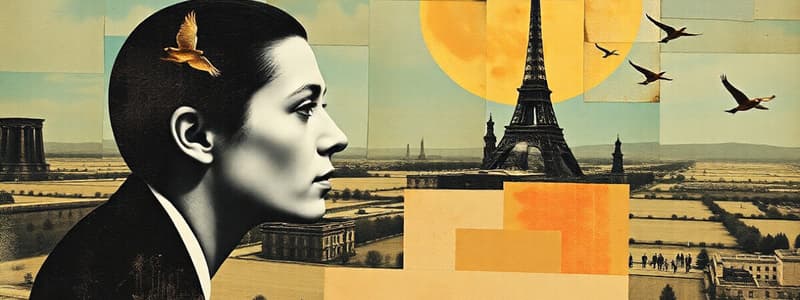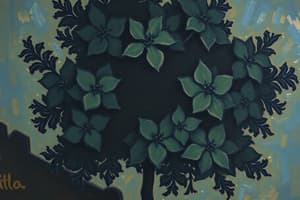Podcast
Questions and Answers
How did Raymond Williams define culture?
How did Raymond Williams define culture?
Raymond Williams defined culture as 'a particular way of life, whether of a people, a period, a group, or humanity in general,' emphasizing that culture includes artistic, intellectual works, and everyday life practices.
What does ideology refer to?
What does ideology refer to?
Ideology refers to a system of ideas, beliefs, and values that shape how individuals and societies perceive and interact with the world, often reinforcing dominant social positions and justifying inequalities.
According to John Storey, what is popular culture?
According to John Storey, what is popular culture?
- Culture that is widely favored or well-liked by many people. (correct)
- Culture used to maintain social hierarchies.
- Culture actually made by people for themselves.
- Culture intended for the elite.
What did Pierre Bourdieu's theories explain?
What did Pierre Bourdieu's theories explain?
What are the characteristics of Film Noir?
What are the characteristics of Film Noir?
What facilitated the emergence of popular culture?
What facilitated the emergence of popular culture?
What did Andrew Ross argue about post-war American culture?
What did Andrew Ross argue about post-war American culture?
Dwight Macdonald believed that mass culture enhanced artistic quality.
Dwight Macdonald believed that mass culture enhanced artistic quality.
According to Dwight Macdonald, how did mass culture affect consumers?
According to Dwight Macdonald, how did mass culture affect consumers?
What is folk culture according to Macdonald?
What is folk culture according to Macdonald?
How did Van den Haag view mass culture?
How did Van den Haag view mass culture?
What do you know about Edward Shils' view of mass culture?
What do you know about Edward Shils' view of mass culture?
In 'Culture and Civilization' Tradition view, what counters the dangers of mass cultural decline?
In 'Culture and Civilization' Tradition view, what counters the dangers of mass cultural decline?
Describe the cultural changes in Nineteenth-Century Manchester.
Describe the cultural changes in Nineteenth-Century Manchester.
What did Matthew Arnold emphasize the role of culture in?
What did Matthew Arnold emphasize the role of culture in?
According to Arnold, what is culture?
According to Arnold, what is culture?
According to Arnold, which of the following are functions of culture?
According to Arnold, which of the following are functions of culture?
According to Arnold, why is education important?
According to Arnold, why is education important?
What is the difference between civilization and cultivation according to Coleridge?
What is the difference between civilization and cultivation according to Coleridge?
What is Leavisism?
What is Leavisism?
According to Leavisites, why is popular fiction bad?
According to Leavisites, why is popular fiction bad?
What is culturalism?
What is culturalism?
What is the Centre for Contemporary Cultural Studies (CCCS)?
What is the Centre for Contemporary Cultural Studies (CCCS)?
What is 'The Uses of Literacy'?
What is 'The Uses of Literacy'?
What is 'The Making of the English Working Class' about?
What is 'The Making of the English Working Class' about?
What are the main points of Stuart Hall and Paddy Whannel's work?
What are the main points of Stuart Hall and Paddy Whannel's work?
How does Marxist Approach view Culture?
How does Marxist Approach view Culture?
Base and Superstructure
Base and Superstructure
How Classic Marxist Approach View Popular Culture?
How Classic Marxist Approach View Popular Culture?
Who was William Morris?
Who was William Morris?
According to William Morris, what should art be?
According to William Morris, what should art be?
Who are some key figures of the Frankfurt School?
Who are some key figures of the Frankfurt School?
What is Althusserianism?
What is Althusserianism?
Who was Antonio Gramsci?
Who was Antonio Gramsci?
What is Articulation in Post-Marxist Cultural Studies?
What is Articulation in Post-Marxist Cultural Studies?
What is the Primary Object of Study in Post-Marxist Cultural Studies?
What is the Primary Object of Study in Post-Marxist Cultural Studies?
How does Freud view dreams?
How does Freud view dreams?
How is Freudian Psychoanalysis used as a Method to Describe Texts?
How is Freudian Psychoanalysis used as a Method to Describe Texts?
What is fore-pleasure?
What is fore-pleasure?
Who was Jacques Lacan?
Who was Jacques Lacan?
According to Jacques Lacan, the moment in infancy when a child recognizes itself in a mirror, forming the basis of self-identity, is an example of what?
According to Jacques Lacan, the moment in infancy when a child recognizes itself in a mirror, forming the basis of self-identity, is an example of what?
What do you know about the concept of the male gaze?
What do you know about the concept of the male gaze?
Who is Slavoj Žižek?
Who is Slavoj Žižek?
Who was Ferdinand de Saussure?
Who was Ferdinand de Saussure?
Match the following terms to their definitions:
Match the following terms to their definitions:
How Structuralists Analyze Cultural Texts?
How Structuralists Analyze Cultural Texts?
Who was Claude Lévi-Strauss?
Who was Claude Lévi-Strauss?
According to Lévi-Strauss, why did he study the primitive?
According to Lévi-Strauss, why did he study the primitive?
What does Wright's Analysis of the Western show?
What does Wright's Analysis of the Western show?
The civilization restores order before disappearing.
The civilization restores order before disappearing.
What is Binary Opposition?
What is Binary Opposition?
Flashcards
Raymond Williams' Definition of Culture
Raymond Williams' Definition of Culture
Culture is a particular way of life, encompassing everyday practices and traditions.
Ideology
Ideology
A system of ideas and beliefs that influences how people perceive the world and maintain power structures.
John Storey's Definition of Popular Culture
John Storey's Definition of Popular Culture
Popular culture is culture that is widely favored or enjoyed by many people.
Raymond Williams' Definition of Popular Culture
Raymond Williams' Definition of Popular Culture
Signup and view all the flashcards
Pierre Bourdieu
Pierre Bourdieu
Signup and view all the flashcards
Film Noir
Film Noir
Signup and view all the flashcards
Emergence of Popular Culture
Emergence of Popular Culture
Signup and view all the flashcards
Andrew Ross on Post-War Culture
Andrew Ross on Post-War Culture
Signup and view all the flashcards
Dwight Macdonald's Mass Culture Critique
Dwight Macdonald's Mass Culture Critique
Signup and view all the flashcards
Folk Culture
Folk Culture
Signup and view all the flashcards
Mass Culture (Van den Haag)
Mass Culture (Van den Haag)
Signup and view all the flashcards
Mass Culture (Edward Shils)
Mass Culture (Edward Shils)
Signup and view all the flashcards
Matthew Arnold's View
Matthew Arnold's View
Signup and view all the flashcards
Functions of Culture (Arnold)
Functions of Culture (Arnold)
Signup and view all the flashcards
Education in Arnold's View
Education in Arnold's View
Signup and view all the flashcards
Leavisism
Leavisism
Signup and view all the flashcards
Culturalism
Culturalism
Signup and view all the flashcards
Centre for Contemporary Cultural Studies
Centre for Contemporary Cultural Studies
Signup and view all the flashcards
Frankfurt School
Frankfurt School
Signup and view all the flashcards
Antonio Gramsci's Hegemony
Antonio Gramsci's Hegemony
Signup and view all the flashcards
Structuralism
Structuralism
Signup and view all the flashcards
Ferdinand de Saussure
Ferdinand de Saussure
Signup and view all the flashcards
Binary Opposition
Binary Opposition
Signup and view all the flashcards
Roland Barthes' Myth
Roland Barthes' Myth
Signup and view all the flashcards
Michel Foucault's Focus
Michel Foucault's Focus
Signup and view all the flashcards
Panopticism
Panopticism
Signup and view all the flashcards
Cultural Texts Analysis
Cultural Texts Analysis
Signup and view all the flashcards
Freudian Psychoanalysis
Freudian Psychoanalysis
Signup and view all the flashcards
Study Notes
Key Concepts in Cultural Studies
- Culture: A "whole way of life," encompassing intellectual and artistic achievements, as well as everyday practices and traditions.
- Popular Culture: Culture actively consumed by large groups, contrasted with elite culture, often shaped by mass media and encompassing practices, beliefs, and objects dominant in society at a particular time.
- Folk Culture: A spontaneous and organic form of cultural expression arising from local communities.
Key Figures and Theories
- Raymond Williams: Defined culture as a "whole way of life," including everyday practices and traditions, emphasizing its dynamic nature.
- Dwight Macdonald: Contrasted folk and mass culture, highlighting how mass culture is commercialized and imposed on society by mass media, differing from folk culture's organic evolution.
- Matthew Arnold: Defined culture as the pursuit of perfection and elevation of moral and intellectual standards. Culture is linked to refinement and social improvement.
- Michel Foucault: Analyzed power, knowledge, and discourse, revealing how institutions and language shape human behavior and social structures. His theories explore the interplay of power, knowledge, and social norms.
- Jacques Lacan: Reinterpreted Freud through a structuralist lens, emphasizing the role of language and the unconscious in shaping identity. He analyzed the "mirror stage", where self-recognition begins.
- Laura Mulvey: Analyzed the "male gaze" in film, discussing how traditional Hollywood cinema often objectifies women and positions them as passive objects of male desire.
- Edward Said: Critiqued Western representations of the "Orient" in his work, "Orientalism." He argued that these representations serve Western political and ideological interests.
- Antonio Gramsci: Developed the concept of hegemony, describing how ruling classes maintain control through ideology rather than force, influencing culture and social norms.
- The Frankfurt School: This group of Marxist theorists critically analyzed mass culture, arguing that it was used by capitalist interests to manipulate and maintain the status quo.
- Lévi-Strauss: Used structuralism to examine myths across different societies, arguing that certain fundamental structures and binary oppositions underlie human thought.
- Roland Barthes: Studied popular culture, analyzing cultural signs and how they create meaning, including the notion of "myth," examining texts and their cultural contexts.
- Claude Lévi-Strauss: Studied the commonalities in seemingly disparate cultures, revealing universal structures of thought.
Key Concepts
- Base and Superstructure: In Marxist analysis, the base refers to the economic foundation of society (e.g., production and property relations), and the superstructure is the cultural, political, and ideological structures built upon that base (e.g., institutions, laws, ideas). Base shapes the superstructure.
- Hegemony: The dominance of a particular group's ideas and values, and the way they are integrated into the culture of society. Rulers seek to control culture to maintain their power.
- Myth: In Barthes' discourse, a second-order semiotic system where cultural signs acquire additional meaning beyond their literal sense. Myths reinforce specific ideologies, or the status quo.
- Binary Opposition: A common structuralist concept that identifies pairs of opposing concepts (e.g., good/evil, male/female, rational/irrational) that are fundamental to the structures of language and thought.
- Signifier and Signified: In semiotics (the study of signs), the signifier is the physical form of a sign, and the signified is the mental concept or idea associated with it. These concepts are central to understanding how meaning in culture is constructed.
- Orientalism: The discourse of Western representation and interpretation of non-Western cultures. Often used to justify colonialism, orientalism reinforces inaccurate and stereotypical views of the “Orient.”
- Panopticism: A concept from Foucault's work, referring to a system of constant surveillance, where individuals regulate their behavior due to the potential for being observed. This observation is not overtly active but potentially always present.
Other Important Terms
- Civilisation: Material progress and social order in society.
- Cultivation: Refinement of thought, values, and morals found in individuals and in society.
- Mass culture: Popular culture produced for large-scale consumption, often characterized by standardization, commodification and often seen as a tool of mass control by dominating ideology.
- Folk culture: Locally produced culture, organic to communities, often created and passed down through oral tradition.
- Structuralism: An approach to analyzing texts and objects, where researchers look for underlying, recurring structures and common patterns in culture.
- Psychoanalysis: A theory and method used to understand the unconscious mind and how it shapes behavior and experiences. It has been used by some scholars to analyze texts and culture.
Studying That Suits You
Use AI to generate personalized quizzes and flashcards to suit your learning preferences.



